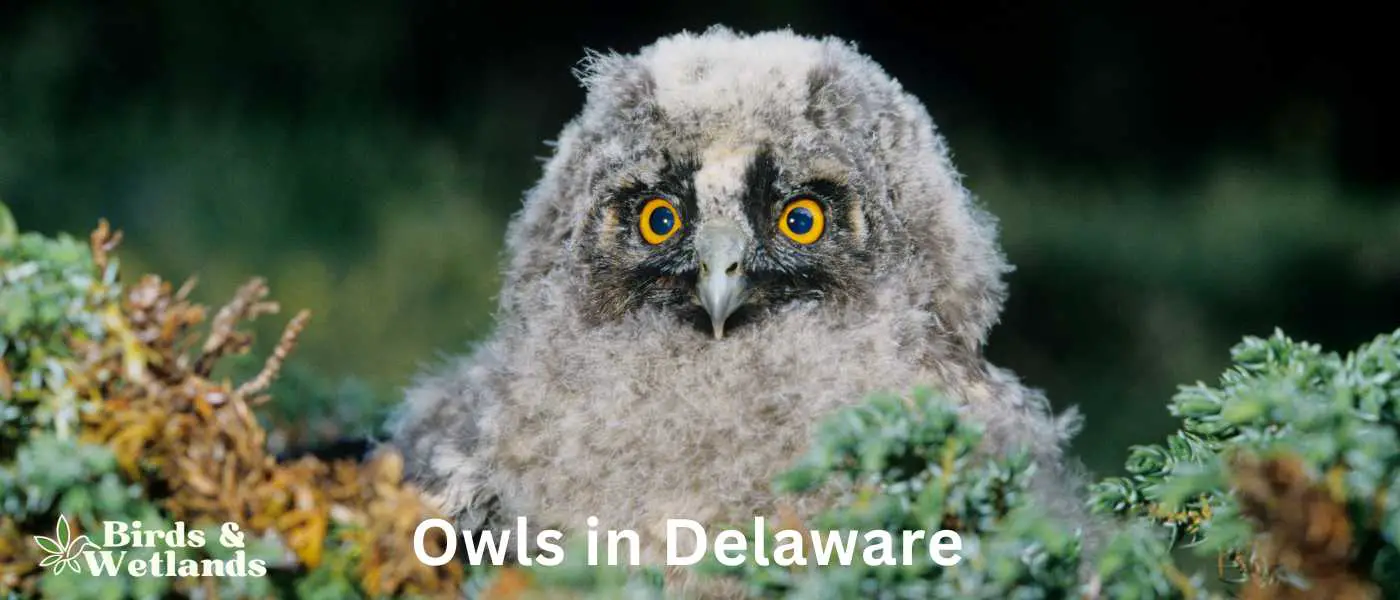Across the varied habitats of Delaware, from its sprawling forests to its serene coastal wetlands, a diverse collection of owls makes its home. These silent hunters of the twilight hours hold an indispensable role in the state’s ecological balance, operating as both predators and prey within their ecosystems.
Delaware Owls
| Owl Species | Frequency in Delaware | Presence in Delaware | Where to Find in Delaware |
|---|---|---|---|
| Great Horned Owl | High | Statewide | Brandywine Creek State Park, Wilmington; Cape Henlopen State Park, Lewes |
| Eastern Screech Owl | High | Statewide | White Clay Creek State Park, Newark; Bombay Hook National Wildlife Refuge, Smyrna |
| Barred Owl | Moderate | Northern and Central Delaware | Lums Pond State Park, Bear; Blackbird State Forest, Smyrna |
| Northern Saw-whet Owl | Low | Northern Delaware | Redden State Forest, Georgetown; Middle Run Valley Natural Area, Newark |
| Short-eared Owl | Low (Seasonal) | Coastal Areas and Open Fields | Prime Hook National Wildlife Refuge, Milton; Little Creek Wildlife Area, Dover |
| Long-eared Owl | Low | Scattered Across State | Ashland Nature Center, Hockessin; Fort DuPont State Park, Delaware City |
| Snowy Owl | Very Low (Seasonal) | Coastal Areas in Winter | Delaware Seashore State Park, Rehoboth Beach; Port Mahon Wildlife Area, Dover |
| Barn Owl | Low | Scattered Across State | Woodland Beach Wildlife Area, Smyrna; Nanticoke Wildlife Area, Seaford |
Owl Species Found in Delaware
Great Horned Owl (Bubo virginianus)


Great Horned Owl Sound
Scientific Name:Bubo virginianus
Length: 18.1-24.8 in
Wingspan: 39.8-57.1 in
Weight: 32.1-88.2 oz
The Great Horned Owl is a large owl with long wings and a large head. It’s one of the most common owls in North America.
Great Horned Owls are large, stocky birds with soft feathers that are gray to brown on their backs and white on their chests. Their faces are characterized by two black “ear” tufts, which can be raised or flattened depending on the owl’s mood. The eyes are yellow, orange, or red in color.
The habitat of the Great Horned Owl is a variety of different environments such as forests and deserts. They also live near water sources such as lakes, streams and rivers where they can hunt for fish.
The diet of the Great Horned Owl consists primarily of small mammals such as mice and rats; however they will also eat other rodents such as squirrels, rabbits and porcupines. They have been known to eat skunks too.
Eastern Screech-Owl (Megascops asio)


Eastern Screech-Owl Sound
Scientific Name: Megascops asio
Length: 6 to 10 in
Wingspan: 8 to 24 in
Weight: 4 – 8.5 oz
The Eastern Screech-Owl is a small owl species native to most wooded environments of the eastern half of North America, from the Canadian provinces to Florida and Texas.
Eastern Screech-Owls are relatively small and exhibit a complex pattern of gray or reddish-brown coloration, which provides excellent camouflage against tree bark.
These owls are known for their distinctive call, which is often described as a haunting trill or a whinny-like sound. Despite their name, they do not actually produce a “screech.”
Eastern Screech-Owls feed on a variety of prey, ranging from small mammals and birds to insects and even earthworms. It is primarily nocturnal, hunting at night from a low perch and swooping down onto prey.
Eastern Screech-Owls nest in tree cavities or abandoned woodpecker nests, but they readily adapt to nesting boxes where natural cavities are not available. They typically lay between 2 to 6 eggs, which are incubated primarily by the female.
Barred Owl (Strix varia)

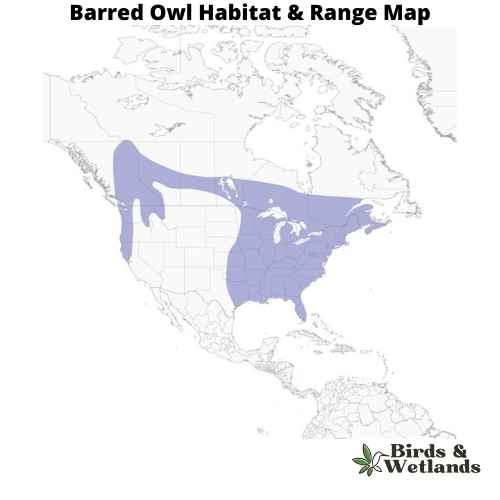
Barred Owl Sound
Scientific Name: Strix varia
Length: 40 to 63 cm (16 to 25 in)
Wingspan: 96 to 125 cm (38 to 49 in)
Weight: 468 to 1,150 g
The Barred Owl is a medium-sized owl with a barred pattern on its chest and belly. They have large yellow eyes that allow them to see well in low light conditions. Their ears are not very large which means they do not hear very well but they have excellent hearing abilities which allow them to detect sounds up to 1 mile away. Their feathers are brown and streaked with white, and they have black bars on their chests and wings.
Their habitats include forests, woodlands, orchards, parks, farmland and suburban backyards.
Barred Owls (also known as hoot owl) eat small mammals such as mice, rats and squirrels. They also eat insects such as beetles or grasshoppers. These owls hunt during the day when it is light out so that they can see their prey better than at night when they would be using senses other than sight like sound or smell to find their food source.
Barred owls are monogamous birds which means they mate for life. They build nests in trees or cavities on the ground and lay 2-4 eggs per year. The incubation period for these eggs lasts about 28 days before hatching takes place.
Northern Saw-whet Owl (Aegolius acadicus)

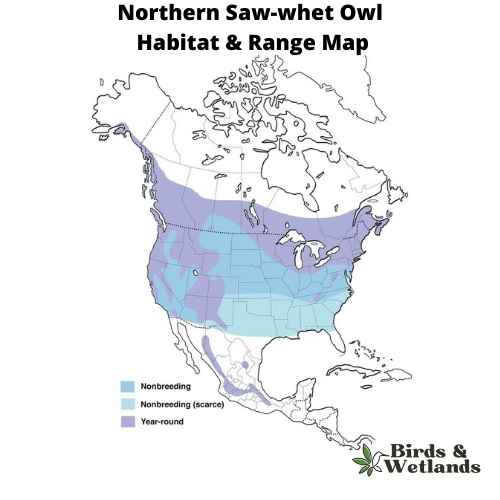
Northern Saw-whet Owl Sound
Scientific Name: Aegolius acadicus
Length: 17–22 cm (6.7–8.7 in)
Wingspan: 42–56.3 cm (16.5–22.2 in)
Weight: 54 to 151 g (1.9 to 5.3 oz)
The Northern Saw-whet Owl is a tiny, speckled gray owl and it’s one of the smallest owls in North America. It’s also known as the Little Owl or Wood Owl in some areas.
Northern Saw-whet Owls have dark brown eyes, white eyebrows, and yellow beak. It has brownish-grey feathers that are spotted with white. The owl’s legs are covered in feathers and appear nearly invisible when the bird is perched on a branch or tree.
In the winter they migrate south to warmer climates. They prefer to live in dense coniferous forest with large trees but will occasionally nest in shrubs or other vegetation that can protect them from predators.
The Northern Saw-whet Owl eats mice and voles (small rodents), small birds, frogs, salamanders, moles and shrews, but unlike most owls they chop their prey up and spread over a few meals. They will also eat insects like beetles and grasshoppers if they are available. It hunts from a perch at night using its excellent hearing to locate prey items within about 30 feet (9 meters) of its nest.
These owls nest in tree cavities usually located close to water sources such as lakes or rivers where they can find their food source (insects). They lay 2-4 eggs at one time which incubate for about 30 days before hatching.
The long-eared owl (Asio otus)

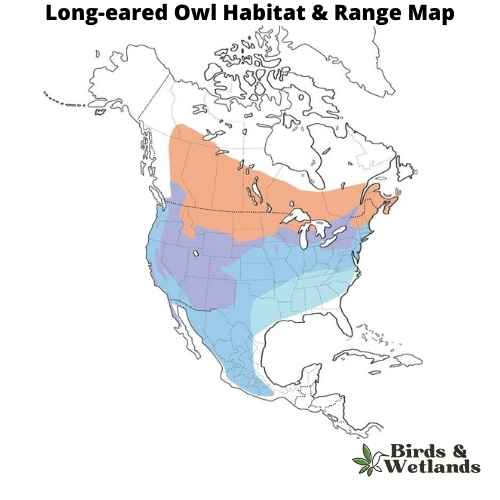
Long-eared Owl Sound
Scientific Name: Asio otus
Length: 12 and 16 in
Wingspan: 2 ft 10 in to 3 ft 4 in
Weight: 5.6 to 15.3 oz
The Long-eared Owl is a medium-sized owl species known for its distinctively long ear tufts, which can be raised or lowered depending on the bird’s mood or intention.
Long-eared Owls have mottled brown and cream plumage, which provides excellent camouflage among the trees. Their most distinctive features are their long, black-tipped ear tufts, which are set closer to the center of the head than in most other owl species.
These owls inhabit a wide variety of habitats, including deciduous and coniferous forests, woodlands, and even semi-deserts.
The Long-eared Owl’s diet primarily consists of small mammals, especially voles, but they will also take small birds and insects. They are skillful hunters, often capturing prey from a perch or in flight.
In terms of nesting behavior, Long-eared Owls do not construct their own nests, instead they take over old nests built by other bird species, usually those of corvids or other large birds. They lay an average of 4 to 5 eggs, which are incubated by the female while the male provides food.
Short-eared Owl (Asio flammeus)


Short-eared Owl Sound
Scientific Name: Asio flammeus
Length: 13–17 in
Wingspan: 33 to 43 in
Weight: 7.3–16.8 oz
The Short-eared Owl is a medium-sized owl species with a wide distribution, found across North and South America, Europe, Asia, and many Pacific islands. Despite its name, the “ears” of the Short-eared Owl are not often visible, as they are small and tend to blend with the bird’s feathers.
The owls are predominantly brown with buff and white accents throughout their body and wings, and dark patches around their yellow eyes.
Short-eared Owls diet consists largely of small mammals, especially voles. However, they are opportunistic hunters and will also prey on a variety of other animals, including other birds, when available.
Their habitat is characterized by open areas like grasslands, marshes, and tundra. They nest on the ground, which is unusual for owls, and this makes them vulnerable to ground predators. As such, they often live in areas with tall grasses or other ground cover for protection.
Barn Owl (Tyto alba)

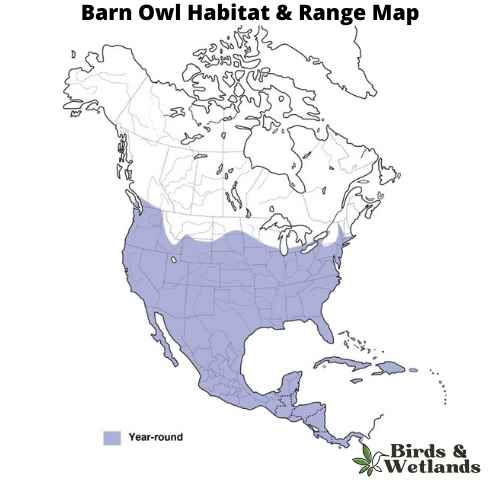
Barn Owl Sound
Scientific Name: Tyto alba
Length: 13 to 15 in
Wingspan: 31 to 37 in
Weight: 9.2 oz
The Barn Owl is a widespread species of owl known for its distinctive heart-shaped facial disc.
Barn Owls are medium-sized owls, they are pale overall with golden-brown wings and back, contrasted by a white face, chest, and belly. Their most notable feature is their heart-shaped facial disc, which helps channel sound to their ears.
Barn Owls are typically found in open habitats, including farmland, woodland, and marshes. They are named for their habit of nesting in human structures such as barns, church towers, and in the hollows of large trees. These owls are nocturnal, hunting at night and roosting during the day.
The diet of Barn Owls primarily consists of small mammals, particularly rodents such as mice and rats. They are known for their silent flight, which allows them to sneak up on their prey without detection.
Barn Owls have a unique nesting behavior. They do not build nests, but instead, lay their eggs directly on the bare surface of a secluded ledge or cavity. A female typically lays 4-7 eggs, and both parents help incubate the eggs and care for the chicks.
Snowy owl (Bubo scandiacus)
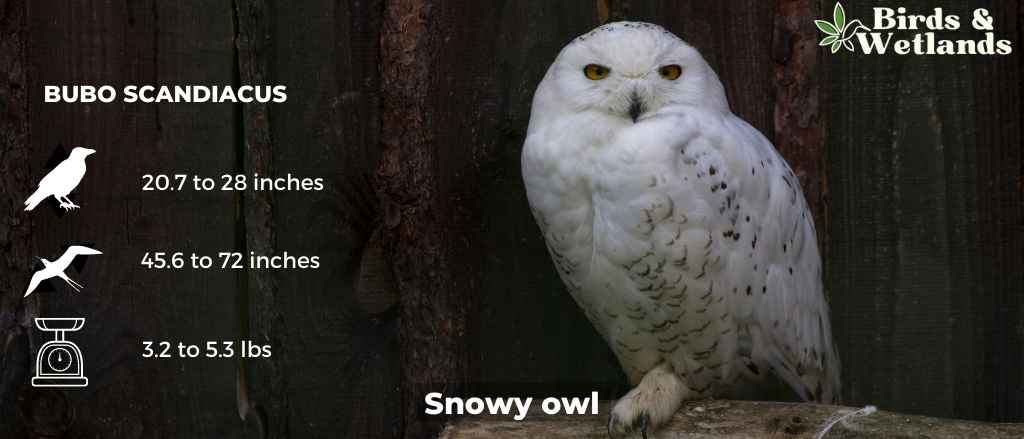
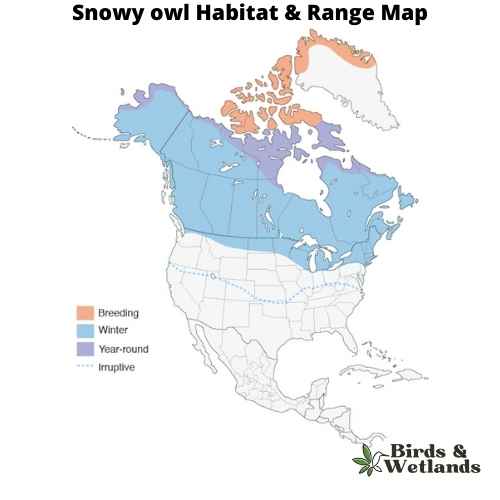
Snowy owl Sound
Scientific Name: Bubo scandiacus
Length: 20.7 to 28 in
Wingspan: 3 ft 10 in to 6 ft 0 in
Weight: 3.2lb to 5.3lb
The Snowy Owl, is of the most well-known species of owls, the Snowy Owl is renowned for its striking appearance and adaptations to its extreme environment.
Snowy Owls are medium sized birds that possess a rounded head, yellow eyes, and a black beak. The most distinctive feature of the Snowy Owl is its white plumage, which provides effective camouflage in its snowy habitat. Male Snowy Owls are often almost completely white, while females and younger owls have more extensive dark barring on their plumage.
Unlike many owl species, Snowy Owls are primarily diurnal, which means they are active during the day. This is an adaptation to life in the Arctic, where there can be 24 hours of daylight in the summer. Their diet mainly consists of small mammals, particularly lemmings, but they are known to eat a variety of animals including birds, fish, and even carrion when necessary.
Snowy Owls nest on the ground, usually on a mound or boulder. Their breeding success is closely tied to the availability of food, and in good years a single pair of owls can raise a large brood of chicks.
Where to Spot Delaware’s Owls
Bombay Hook National Wildlife Refuge, Smyrna: This wildlife refuge is a major stop on the Atlantic Flyway and is known for its diversity of bird species, including several owl species. Great Horned Owls, Barred Owls, and Eastern Screech Owls are commonly seen, and Short-eared Owls can be spotted during the winter.
Cape Henlopen State Park, Lewes: The park’s varied habitats – from maritime forests to salt marshes and dunes – attract many bird species. Owl sightings include Great Horned Owls, Barred Owls, and Eastern Screech Owls. It’s also a notable location for spotting migrating birds.
Prime Hook National Wildlife Refuge, Milton: Another significant site on the Atlantic Flyway, this refuge is known for its waterfowl, but it also hosts several owl species, including Barn Owls and Barred Owls.
Brandywine Creek State Park, Wilmington: The park’s mix of meadows and woodlands make it a good spot to see a variety of owls, including Great Horned Owls, Barred Owls, and Eastern Screech Owls. It’s especially good for spotting owls during the fall migration season.
Delaware Seashore State Park, Rehoboth Beach: This coastal park is a fantastic place for birdwatching overall, and during the winter, you have a good chance of spotting Snowy Owls along the beach.
Remember, owl spotting requires patience and quietness. Be respectful of the birds and their habitats, and always follow any rules or guidelines provided by the park or wildlife refuge.
| State | Main Owl Watching Sites |
|---|---|
| Delaware Owls | Bombay Hook National Wildlife Refuge, Brandywine Creek State Park |
| Maryland Owls | Blackwater National Wildlife Refuge, Catoctin Mountain Park |
| Pennsylvania Owls | Hawk Mountain Sanctuary, Allegheny National Forest |
| New Jersey Owls | Great Swamp National Wildlife Refuge, Cape May Point State Park |
Tips on How to Spot Owls in Delaware
Research Your Species: In Delaware, you can find Barred Owls, Great Horned Owls, Eastern Screech Owls, Short-eared Owls, and even Snowy Owls during winter migration. Start by learning about the species, their habitats, and their distinct calls.
Time Your Search: Most owl species are primarily nocturnal, so the best time to spot them is usually just after sunset or just before sunrise. However, Short-eared Owls are often active during the daytime, particularly in winter.
Locate Owl Habitats: Owls can be found in various habitats such as forests, open fields, wetlands, and even suburban areas. For example, Barred Owls prefer mature woods near water bodies, while Short-eared Owls prefer open fields and marshes. Visit state parks and nature reserves that have these habitats.
Listen for Owl Calls: Familiarize yourself with the calls of the owl species in Delaware. This can help you locate them even when they are hidden. Online resources and birding apps often provide sound clips.
Watch for Signs: Look for signs of owl activity, such as white wash (owl droppings), pellets, and feathers beneath roosting spots.
Equip Yourself: Invest in good quality binoculars for bird watching. A night vision device or red flashlight can also be useful for spotting owls in the dark.
Join a Birding Group: Birding societies and clubs often organize owl-spotting trips and can provide tips on the best local spots to see owls. The Delmarva Ornithological Society is a good start.
Respect the Owls: Always observe owls from a distance to avoid causing them stress. Do not disturb their nests and avoid shining bright lights at them. Use playback calls sparingly if at all, as they can be disruptive.

